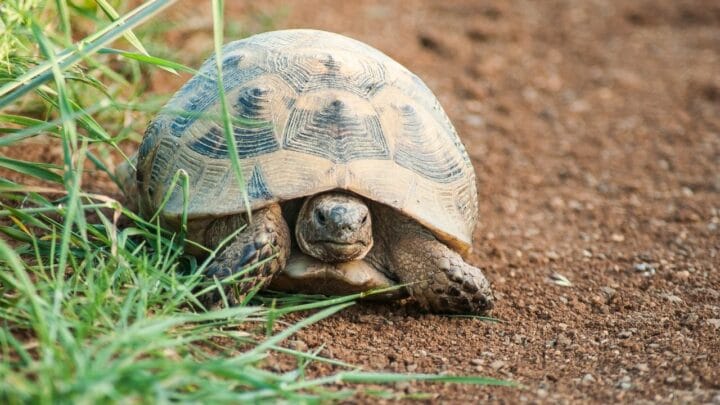The turtle and tortoise are the oldest reptiles and have lived on earth for millions of years. Over 300 species of turtles and tortoises have been found around the world.
Unlike turtles, which can live in the water and on land, tortoises live entirely ashore. Their carapaces (shell) and flippers (front feet) have evolved into this lifestyle.
Their shell has developed into very effective armor. Their flippers make great shovels for digging and work pretty well for moving them about.
To learn more about how a tortoise can technically live without its shell, read on.
Can a tortoise technically live without its shell?
No, it cannot technically live without its shell. A tortoise’s shell functionally works as the backbone and ribs of the tortoise. Veins run through it, and a turtle can feel your touch on its shell. If they lose their shell, though, or if it is badly damaged, they can die.
A Tortoise Shell is its Skeleton
The spine, ribs, and upper shell of a tortoise are called the carapace, made of bone-like plates fused to form a turtle’s back. The underbelly (plastron) of a tortoise’s shell comprises plates that cover its soft underside and offer protection from below.
The tortoise has a shell that is not as streamlined as its cousin, the turtle, is. It does not need to swim, so it does not need that attribute.
What it has instead is a thicker shell than its relative’s.
The bone-like shell of the tortoise is sheathed with a coat of keratin (the same material as fingernails) to make it tough. However, even though it is bone tough, predators, men, or incidents can damage a tortoise’s shell.
If the shell of a tortoise is not damaged too severely, or if it gets help in time, it can live. However, if a tortoise’s shell is damaged too severely, then it can’t live without it.
A Tortoise’s Hard Shell is its Armor, too
Only in a cartoon will you see a turtle remove its shell and gadabout. However, the tortoise depends on its shell to keep it safe from natural predators in the animal kingdom.
These enemies include foxes, coyotes, snakes, and roadrunners.
Once they are grown and have some size on them, they are not easy targets. However, baby tortoises, and those who do not learn to dig a hole and hide, have a hard time surviving.
Small tortoises are targets for the enemies mentioned above, and they have learned to dig holes and hide from them.
Once a tortoise has a bit of size on it, that and the fact its shell is very hard, offers tortoises a lot of protection.
A Tortoise’s Shell is its Skin, too
Our skin protects us from our bodies, and a tortoise’s shell works in much the same way. However, because it is attached to the nervous system and has a blood supply, a tortoise’s shell can feel your touch.
That is pretty cool because this evolutionary feature means they can feel branches and leaves touch their shells as they lumber along. This would give them a spatial awareness they would not have if they could not feel and see their surroundings.
Unlike snakes and frogs, tortoises do not shed their shell to grow. As a tortoise grows, so do its plates (scutes or dermal plates). It just happens very slowly.
Different Tortoises have Different sizes – Different Shells, too
Tortoises range in size from very small to animals large enough that a person can climb aboard for a ride.
The smallest of these creatures is the Speckled Cape Tortoise. Male Speckled Cape Tortoises grow to about three inches when grown.
The largest tortoise on record is Esmeralda, who makes his home in Seychelles and is the largest tortoise in the world. Weighing in at a massive 670 pounds, he is thought to be about 170 years old.
Esmeralda is a boy, but he doesn’t care what he is called as long as he is called to dinner. Because an animal this large requires a lot of food to maintain such a mass.
Esmeralda is an Aldabra tortoise and one of many who call Bird Island on the Aldabra Atoll home. The Aldabra atoll is home to the largest population of these mighty creatures and numbers in the thousands.
Since this area’s far from man, it has kept them safe so far. In addition, the protection of government entities and individuals who do not want to see them come to harm has kept this large population of tortoises safe.
Frequently Asked Questions about Whether a Tortoise Can Live Without its Shell
Does a tortoise ever quit growing?
They do not really quit growing, but instead of getting larger once they have reached a specific size, they get thicker more than they get larger. Therefore, age is not a determination of when they are full-grown because they grow so slowly.
How long do tortoises live?
Tortoises can live to 100 years old. The oldest known specimen was Adwaita, who lived to the ripe old age of 250 years. That is quite an accomplishment for any tortoise.
Now You Know – A Tortoise Must Have a Shell to Live In
No, a tortoise cannot live without its shell, and now you know why. Its shell is so much more than a pretty adornment or protection.
It is part of its entire body and works in conjunction with its organs to keep it alive. Whether tiny or the size of a pony, tortoises need their own shell.
Some are drab, while others are patterned with colorful designs. The appearance of a tortoise’s shell does not mean much to it, but its protective attributes do.
So the next time you see a tortoise, leave it to meander on its way. They do not get in a hurry to be where they are going, but they get there eventually.


